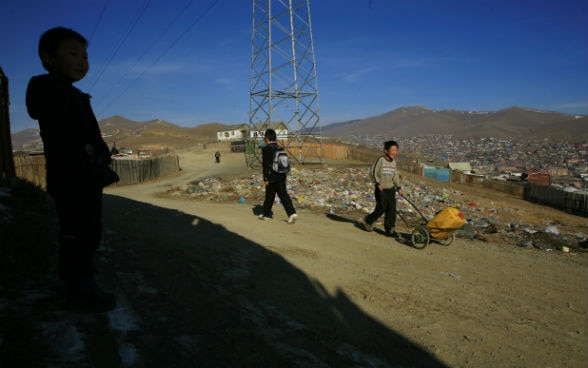
Access to drinking water for residents of the ger districts is limited to public kiosks (water distribution points), which are open only some hours per day and often run out of water. According to estimates, the water consumption of people living in ger districts is limited to 6-10 litres per day, per person. This is well below the minimum level of 15 litres per day, per person, prescribed by the World Health Organization.
Ninety-five percent of the people living in ger districts use simple pit latrines, which risks polluting underground water and soil. These unsanitary conditions combined with the lack of water represent a public health threat.
Improving access to safe water, better sanitation and proper hygiene practices in Ulaanbaatar’s ger districts was the goal of SDC’s Ger WaSH (water, sanitation, hygiene) Project - a four year project implemented in the Songino Khairkhan district of Ulaanbaatar by Action Contre la Faim (ACF) in Mongolia.
Completed in 2015, the project had a number of impacts on proper sanitation and hygiene practices in the target areas, although challenges remain.
More than 20,000 children from 14 schools and kindergartens in the project’s target areas have now access to improved and rehabilitated toilets and sanitation facilities in their schools and kindergartens.
This accelerated good hygiene practices among schoolchildren and led to a reduction in waterborne diseases among the school-age population, including hepatitis A and dysentery. The number of Hepatitis A cases in the target schools dropped to 3 in 2014 from 121 in 2012, according to the National Statistics Office. Advocating hand-washing practices among children was a key factor in achieving this result.
Advocacy kits on proper hygiene practices were widely distributed, and were considered to be the only comprehensive tool on hygiene promotion for children in Mongolia. The kits were approved by the Ministry of Education and Science as a tool to be used at the national level with regards to the hygiene curriculum.
“Instilling proper hygiene practices among children was an investment in future healthy generations,” said ACF Advocacy Officer P. Ariunaa.
The project remodelled four water distribution kiosks, transforming them into multi-functional centres that included water distribution, public showers and hairdressing services, demonstrating that the kiosks were able to provide better hygiene services while earning additional revenue for further sustainability.
As a result of trainings and advocacy for local residents and staff at water distribution kiosks on water-quality testing and the improvement of water-distribution tools, there was a significant reduction in the bacteriological contamination of household water, confirmed in three consecutive samplings.
In addition, project collaboration with the private sector resulted in the production of 20,000 plastic water containers to transport water from kiosks. The containers were produced in Mongolia and distributed with subsidies in an attempt to provide an alternative to the commonly used chemical containers for drinking water transportation and storage.
Two-hundred-and-fifty households in the target ger districts are also now using eco-toilets provided by the project as an alternative to pit latrines. These improved sanitation facilities – which do not endanger either human or environmental health - are affordable for local residents. At present, the eco-toilets remain the only consistently piloted option for improved environmental on-site sanitation in areas that are not connected to the waste-water system in Mongolia’s densely populated ger districts.
ACF Mongolia’s efforts to improve water and sanitation in Ulaanbaatar’s ger districts through demonstrations of solutions and viable alternatives, which has fed numerous studies and analytical reports, has resulted in policy actions, including imposing a condition on using improved latrines on new land allocations, and the introduction of cost-covering water rates in Ulaanbaatar.

